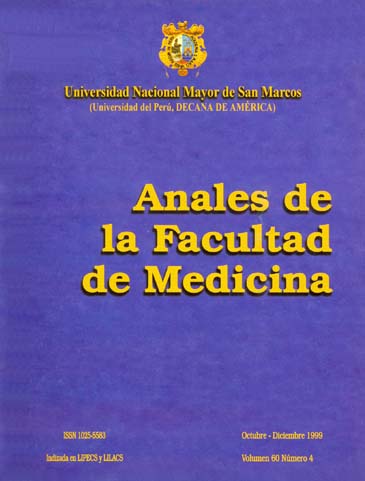Hypoxic-Ischemic Brain Damage in 7-Days-Old Rats: Early Neuronal Changes and the Long-Term Outcome
DOI:
https://doi.org/10.15381/anales.v60i4.4378Keywords:
Brain Damage, Chronic, Cerebral Anoxia, Cerebral Ischemia, ImmunohistochemistryAbstract
OBJECTIVES: To study the changes after hypoxia-ischemia (HI), and to observe both, the vulnerability of the different regions of the brain to HI and the heat shock protein-72 kDa (HSP72) induction and its efects on the neuronal cell. MATERIAL AND METHODS: 7-days-old rats were exposed to left carotid artery ligation followed by 2 h of HI and then they were sacrificed at different time points. Brains extracted at 1-72 h were immunohistochemically study using the HSP-72 and the microtubule associated protein-2 (MAP2) stainings. Brains extracted at 1-4 weeks underwent histopathological study. RESULTS: Loss of MAP2 immunostaining was detected since the 1st hour post-insult, being highest at 24 h. MAP2 reappeared at 72 h in almost all the brain regions of the ligated hemisphere, except the hippocampal CA3 region. At 1-2 weeks post HI, we observed atrophic and cystic lesions. 15-20% of rats did not show any anatomical lesion up to 4 weeks post HI. The HSP72 synthesis was early in the dentate gyrus of the hippocampus, but a delayed induction was observed in the CA3 region; this region showed an increased vulnerability to HI. CONCLUSIONS: Absence of anatomical lesion was observed in 15-20% of rats exposed to HI. Atrophic or cystic lesions are observed since 1-2 weeks after the insult, despite an apparent immunohistochemical recovery at 72 h.Downloads
Published
1999-12-31
Issue
Section
Trabajos originales
License
Copyright (c) 1999 Arturo Ota Nakasone, Tomoaki Ikeda, Hiroshi Sameshima, Tsuyomu Ikenoue, Kiyotaka Toshimori

This work is licensed under a Creative Commons Attribution-NonCommercial-ShareAlike 4.0 International License.
Those authors who have publications with this magazine accept the following terms:
- Authors will retain their copyrights and guarantee the journal the right of first publication of their work, which will be simultaneously subject to Creative Commons Attribution License that allows third parties to share the work as long as its author and its first publication this magazine are indicated.
- Authors may adopt other non-exclusive licensing agreements for the distribution of the version of the published work (eg, deposit it in an institutional electronic file or publish it in a monographic volume) provided that the initial publication in this magazine is indicated.
- Authors are allowed and recommended to disseminate their work over the Internet (eg: in institutional telematic archives or on their website) before and during the submission process, which It can produce interesting exchanges and increase quotes from the published work. (See El efecto del acceso abierto ).
How to Cite
1.
Ota Nakasone A, Ikeda T, Sameshima H, Ikenoue T, Toshimori K. Hypoxic-Ischemic Brain Damage in 7-Days-Old Rats: Early Neuronal Changes and the Long-Term Outcome. An Fac med [Internet]. 1999 Dec. 31 [cited 2025 Jun. 7];60(4):235-43. Available from: https://revistasinvestigacion.unmsm.edu.pe/index.php/anales/article/view/4378



